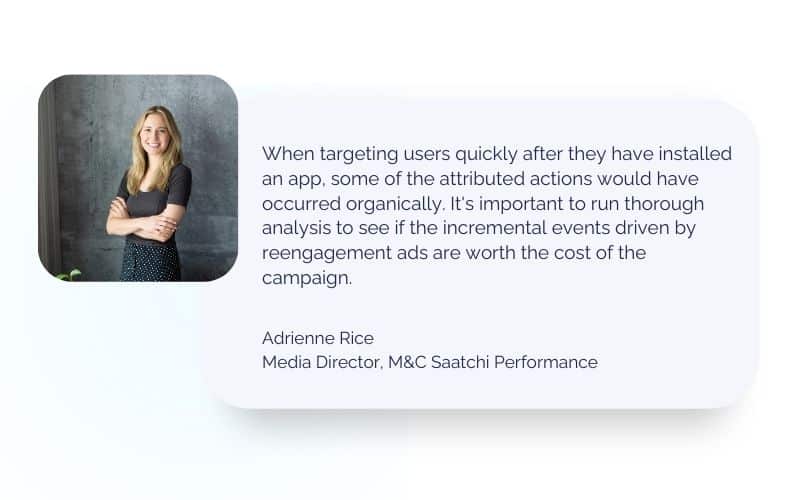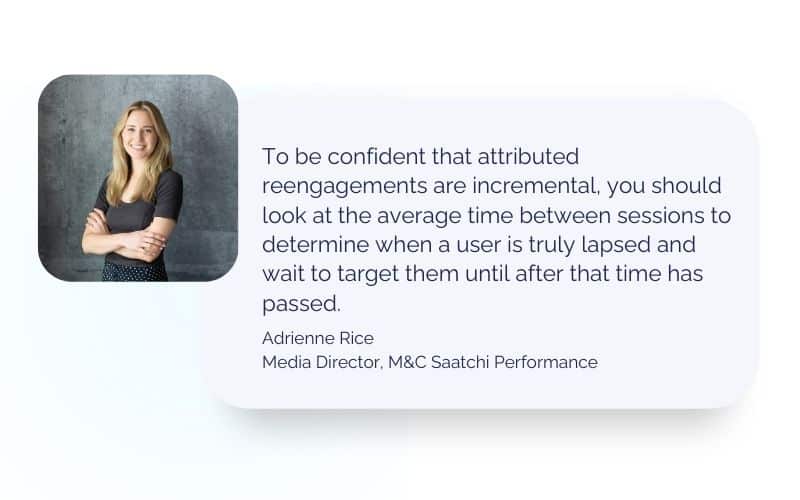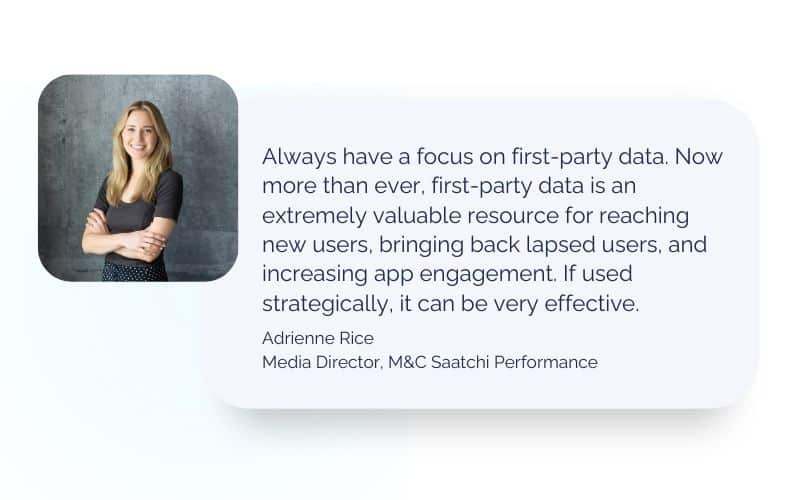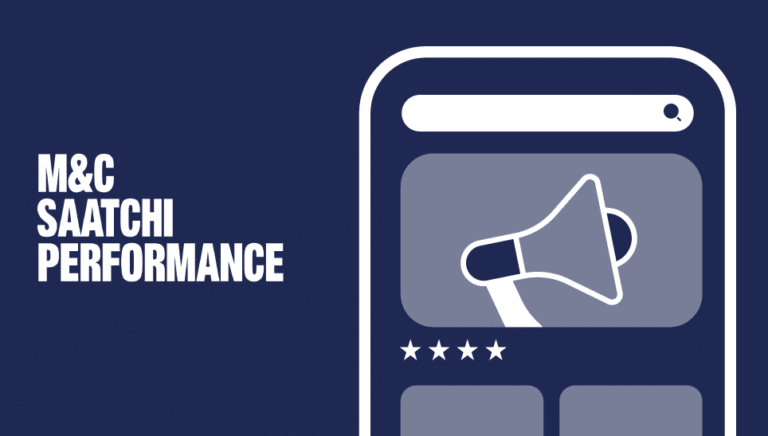Adrienne Rice, Media Director at M&C Saatchi Performance
Adrienne joined M&C Saatchi Performance in 2019 and has successfully led media investment on campaigns across multiple key accounts. Adrienne is an expert in performance media for e-commerce and subscription-based advertisers and has spoken on multiple occasions about subjects like how to implement SKAN successfully. As media director, Adrienne ensures that client media investments are spent in the most effective channels, with a keen eye on ROAS.
M&C Saatchi Performance is a leading global performance marketing agency and, since 2006, has focused on delivering profitable growth for brands through full-funnel performance marketing.
According to a Gartner survey, marketers are still expecting to spend their marketing dollars in paid channels this year despite the pressure to deliver higher ROI. To help support this need, tactics to drive retargeting and reengagement should be high on the minds of mobile marketers. After all, once marketers have successfully acquired new customers through downloading their app, the next challenge is keeping them engaged or reengaging app users if they have lapsed. Reengagement tactics are often cost-effective methods that can work across many verticals and should not be overlooked by mobile marketers looking to improve their ROI.
What is the difference between retargeting and reengagement?
Though similar, there are distinct differences in these two campaign types. Retargeting is where ads are served to users who have visited a website or interacted with a brand but haven’t yet taken the desired action — for example, completed a purchase or downloaded an app. Retargeting campaigns encourage the user to go back to complete what they were doing.
Reengagement campaigns target inactive app users who have installed but then stopped using the app. The objective here is to re-spark the interest of the user and bring them back to using the app.
What is the aim of an app reengagement ad campaign?
The aim of an app reengagement campaign is to target users who have previously installed your app, get them to return to the app, and then take further action. A variety of user segments can be built for these campaigns according to user behavior. For example, one reengagement campaign might target a new user who has just installed and opened an app to encourage them to open it again. Another campaign might target an established active user who needs more encouragement to take a specific, valuable action like upgrading their subscription. The goal is to remind users of the app’s value so they start using it again.
How is an app reengagement ad campaign different from a regular ad campaign?
Whereas growth or acquisition campaigns focus on attracting new users, app reengagement ads specifically target users who have previously installed the app.
Common strategies for app reengagement:
Two main app reengagement strategies can be deployed: recency and lapsed.
Recency
This strategy targets users who have recently installed an app (e.g., installed fewer than seven days ago) to encourage them to take action while it is still fresh in their minds. The recency strategy is effective because it is easiest to convince someone to take an action close to the time they first showed interest. Recency can increase conversion rates, but it is important to run an always-on incrementality test when taking this approach because many users will take that action regardless of seeing more ads.

Lapsed
This strategy targets lapsed users who installed an app but later uninstalled it or haven’t opened it for a specific time frame, such as no sessions for at least seven days. There should be very little overlap with normal user behavior, and you should be confident that almost all reengagement events are incremental. Bringing back a lapsed user will be more difficult compared to targeting a recent installer, but offering a promo or showcasing a new feature are both effective tactics to reignite interest.

What are the benefits of app reengagement?
Acquiring new customers is costly! According to some studies, the cost of acquiring new customers versus retaining existing ones can be five to 25 times higher, depending on the industry.
Therefore, it makes sense to prevent users from churning when you have gone to all the effort of engaging them in the first place.
Specific benefits include:
- Increased app usage: Reengaging inactive users can lead to increased app usage, session duration, and overall engagement rates.
- Retention: Improves user retention by preventing churn and keeping users active and engaged with the app over time.
- Revenue generation: Reactivating dormant users can lead to increased revenue through in-app purchases, subscriptions, increased average basket size, increased frequency of purchase, etc.
- Enhanced user lifetime value (LTV): By reengaging users, you can extend their lifetime value, since active users are more likely to generate revenue and refer others to the app.
App reengagement tactics
Identify inactive users
Segment the user base to identify users who have become inactive or haven’t used an app for a specific time period. Start simple and test, building out ever more increasing segments as you learn from campaigns.
Define campaign goals
Determine specific desired outcomes through clear KPIs like increasing app opens, boosting session duration, or driving specific actions within the app. Start with simple KPIs and refine them over time as the reengagement strategy becomes more sophisticated.
Tailor ad creatives
All mobile advertisers should create compelling ad creatives that highlight the app’s value, new features, personalized offers, or exclusive content to reignite user interest. At the same time, ensure you have an aligned app store optimization (ASO) strategy to make use of features like Custom Product Pages which can drive far more conversions due to offering specific and relevant content.
Audience targeting
Reengagement targeting is based on first-party data and consists of a list of device IDs or other unique identifiers representing a segment of users who have previously engaged with your app. Currently, reengagement is not possible under SKAdNetwork (although that may change with SKAN 5.0), so make sure you show the App Tracking Transparency (ATT) prompt to collect user opt-ins for iOS.
Tracking & measurement
Work with partners like a mobile measurement partner (MMP) to set up effective tracking. Reengagement can’t work unless tracking is set up correctly to identify users who have reengaged with the app as a result of the campaign.
Audience segmentation
This is a vital element of the plan — and the more specific the better.
Use your MMP events or your SDK data to create custom audience groups based on their user behavior, and then focus on each group’s state of mind to craft the creative messaging. You want to customize the creative to each audience group and focus on what action you want them to take. If they have just installed, focus on getting them to register an account. If they are a lapsed user, offer a promo to bring them back. Or if they are a freemium user, show them what benefits a paid subscription brings. In this way, you can use sequential targeting and messaging to guide users down the funnel and increase their LTV.
Reengagement pitfalls to avoid
- Be mindful of the size of each audience group — small audiences can be difficult and expensive to reach.
- With ATT on iOS, reengagement has become more difficult. A user needs to opt in to tracking within your app as well as the publisher app.
- On Android, reengagement is currently fully functional for all users, but Google’s Privacy Sandbox is due in 2024. Though it will include a reengagement solution, advertisers need to be preparing for its rollout now.
- Focus on frequency. With small audience groups, users can often be bombarded with repetitive ads which result in negative brand sentiment. Limit your reengagement partners to just one or two, or split your audience into different groups so you can control for reach and frequency.























